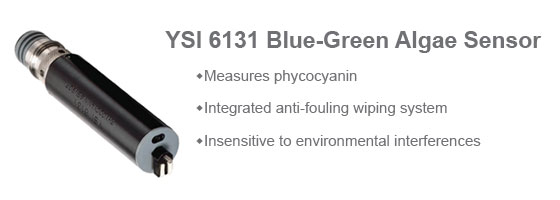Blue-Green Algae Sensor Technology

Blue-green algae (aka: cyanobacteria) monitoring is of growing interest due to the problems some species can present through the production of toxins and compounds that deteriorate the quality of drinking water and through the formation of blooms. Blue-green algae are significant in ecosystem studies and monitoring as well, where they may represent the most abundant primary producer.
YSI’s multiparameter sondes are capable of measuring the approximate levels of blue-green algae using a fluorometer sensor specially attuned to the blue-green algae’s chlorophyll. (See “Methodology” below for more details)
Sensor Details:
- Two versions: One for freshwater (phycocyanin), and another for marine (phycoerythrin) environments
- Optimized for excellent sensitivity for monitoring algal populations at natural levels, providing an early warning for bloom conditions
- Insensitive to potential interferences including chlorophyll, turbidity, and dissolved organics
- Fully compatible with all YSI 6-Series sondes equipped with optical ports with a free and easy firmware upgrade from YSI.com
- Integrated wiping system providing anti-fouling in the most hostile environments
- Durable mechanical features including a non-corroding titanium wiper shaft, replaceable wiper shaft seal, and a new switch controlled wiper parking system to prevent mis-parking
Phycocyanin Blue-Green Algae Sensor (BGA-PC)
The BGA-PC sensor should be used in freshwater and estuarine conditions. Common applications in these environments include:
- Monitoring taste- and odor-causing species in drinking water reservoirs
- Used as a possible presence of harmful or toxic species as part of HAB monitoring systems
- Ecosystem monitoring where blue-green algae are present
Phycoerythrin Blue-Green Algae Sensor (BGA-PE)
The BGA-PE sensor should be used in marine and estuarine conditions. Common applications in these environments include:
- Ecosystem monitoring where blue-green algae may represent important primary producers.
- As a key sensor in a harmful algae bloom monitoring system
- Nutrient cycling studies where blue-green algae are present
Methodology
The simple technique of in-vivo fluorometry (IVF) for locating and measuring algae in real-time has been in use by oceanographers and limnologists for more than 30 years and is based on the direct measurement of the fluorescence of the chlorophyll a in the living algal cells. The same methodology is used to detect the phycobilin pigments found in blue-green algae (aka: cyanobacteria), phycocyanin and phycoerythrin. Blue-green algae pigment fluorescence is the only technique available that is sensitive enough to detect blue-green algae at natural levels without concentration or extraction. Because there is no special sample handling or processing required, IVF is ideal for profiling using moored and real-time data collection with YSI multi-parameter sondes. Similar to the YSI chlorophyll sensor, the blue-green algae sensors do not provide quantitative pigment concentration data, but rather supply relative data on the biomass of blue-green algae. This data is extremely useful for tracking temporal or spatial changes in the distribution of the blue-green algae population and to provide an early warning of increasing biomass that can lead to a bloom. IVF data can be correlated to quantitative data in order to calibrate the IVF data to provide concentration estimates. Without correlation, IVF provides a relative cyanobacteria measure that can be used to track trends and prompt tests that are more specific.
Both blue-green algae sensors (BGA-PC and BGA-PE) are optimized to be as sensitive as possible and used for monitoring natural populations of blue-green algae prior to a full bloom condition. The sensors should be used to monitor natural, temporal, or spatial fluctuations in BGA biomass as well as indicate the possible onset of an algal bloom. During an algal bloom, it is possible the sensor will be over range and cell concentrations could be in the millions of cells/mL.
Calibration Considerations
True calibrations with a primary standard are not practical for IVF applications. IVF measures the relative change in cyanobacterial biomass via pigment fluorescence and the best means of calibration is to compare the IVF data with quantitative data generated from a water sample that was taken in the field when the IVF sensor was deployed. However, users should use a secondary standard to ensure that the sensor is stable and working properly before deployment.
Image Credit: http://www.flickr.com/photos/ms4denmark/ / CC BY-SA 2.0




0 comments